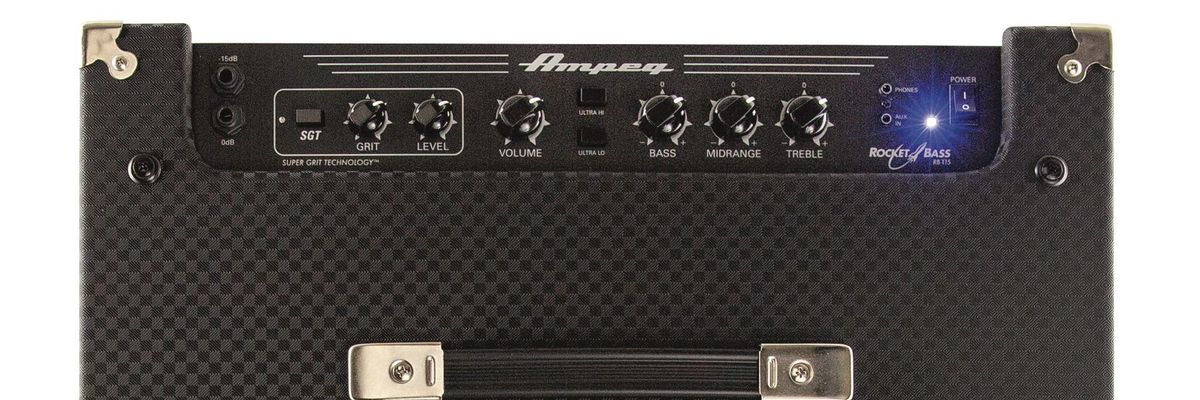Even though Ampeg has made amplifiers based on modern, lightweight technology for years, to many of us the brand represents the gold standard of vintage bass tone. When an engineer or artist asks you to provide an Ampeg sound in the studio or on a gig, they usually want the unmistakable low-mid thump of a B-15 or the unparalleled sub-lows and top-end grit of a ’70s era SVT with tubes that have been cooking for a few hours. So, whenever I try any new product from Ampeg, those sound standards are at the fore of my imagination. The 200-watt Rocket Bass RB-115, from Ampeg’s new Rocket line of combos, captures the essence of many of those foundational Ampeg tones in an amp that’s easy on the wallet, easy to use, and even surprisingly easy to carry.
New Kid in Town, Familiar Face
A classic, straightforward SVT-style control layout makes up most of the RB-115’s top panel—a welcome and reassuring sight. It includes knobs for volume, bass, midrange, and treble. There are also push buttons for the ultra hi and ultra lo boost/cut functions that take the place of an SVT’s rocker switches. The 1/8" jacks for headphones and aux-in are located immediately adjacent to this section. On the opposite side of the panel are controls for the SGT overdrive. This section includes an on/off switch and rotary controls for grit and level. The Rocket RB-115 features two separate instrument inputs. One offers a -15db pad for active basses. The rear section of the RB-115 features a group of ¼" inputs: effects send/return, external speaker out, and a footswitch in to engage the SGT distortion circuit. A DI with a ground lift switch rounds out the features on the back panel. The checkered pattern vinyl and silver cloth grille, by the way, are nice nods to tradition and make the combo look a lot like a B-15 at a glance. At 34 pounds, the RB-115 is relatively light, too.
- Fingerstyle on neck pickup
- Spector P/J with pick
- Nordstrand Acinonyx with overdrive
Straight Into Battle
Immediately after unpacking the Rocket RB-115, I brought it to a low-volume, in-ear-monitored corporate gig, and a few of the other musicians offered compliments on the tone coming via the Ampeg’s DI to their in-ears. Because there’s no tweeter on the RB-115, (a tweeter is available in the RB-210), the speaker output is heavy on low end. Not surprisingly, the DI signal sounds bright by comparison. But in spite of that brightness, my bass never sounded too modern or harsh when listening to the DI signal only—even when playing slap-style with fresh strings.
While the combo might be visually reminiscent of a B-15, the preamp sounds more like a miniature version of a full SVT stack.
Looks Like One, Sounds Like the Other
Back at home, playing through the 15" speaker, the Ampeg sounded warm and massive in the low end with a slightly scooped midrange and very SVT-like high end that emphasizes warmth and personality rather than definition—in the very best way. This is the natural sound of this amp with all the controls at 12 o’clock. And while the combo might be visually reminiscent of a B-15, the preamp sounds more like a miniature version of a full SVT stack—particularly with the ’60s-style passive Lollar neck pickup in a Shabat Tiger 5 J-style bass.
As a longtime fan of the ultra lo boost on older SVT models, I longed to see how the RB-115 handled the switch to hard rock tones, so I grabbed a pick and a Spector Euro LX 4 with active EMG pickups. For starters, the -15db input did its job beautifully, even when I ran the Spector’s onboard EQ at full boost. Very impressive! To achieve more aggressive pick tone, I engaged the ultra hi and ultra lo switches and added midrange from the EQ section to offset the heavy scoop generated by the preset filters. No matter how aggressively I played, the Eminence driver delivered clear highs and lows without breaking a sweat. Recording this tone with a microphone in the center of the cone and no DI, the speaker sound felt better suited for aggressive pick playing than most VST amp simulators I use. Even the very clean, super-articulate EMG pickups responded like they were going through a tube circuit of some kind, because the amp naturally generates a slightly spongey compression—a quality I always appreciate when playing with a pick.

The SGT distortion circuit, which certainly isn’t a feature on a vintage Ampeg, felt less familiar. Playing just a few notes suggested a raw indie rock or garage tonality, so I switched to a Goya-style Nordstrand Acinonyx short scale with flatwounds. It turned out to be a great pairing. The SGT circuit offers midrange-heavy distortion with hints of bright fuzz at times. For players looking for a more scooped Darkglass-type distortion, the SGT might not be a suitable replacement. But it’s great for more old-school sounds.
The Verdict
With its accessible price, manageable size, easy-to-understand design, and modest but classic array of tones, the Ampeg Rocket RB-115 would be an excellent investment for a player looking for their first true professional combo, or somebody moving on to slightly larger shows and bigger sounds. This is also a combo that a seasoned professional could take to a gig with confidence that many essential, fundamental Ampeg tones are there and easy to access. The Ampeg Rocket RB-115 is a great example of how to properly balance tradition and a modern touch—a valuable skill for amp manufacturers and players alike.
















